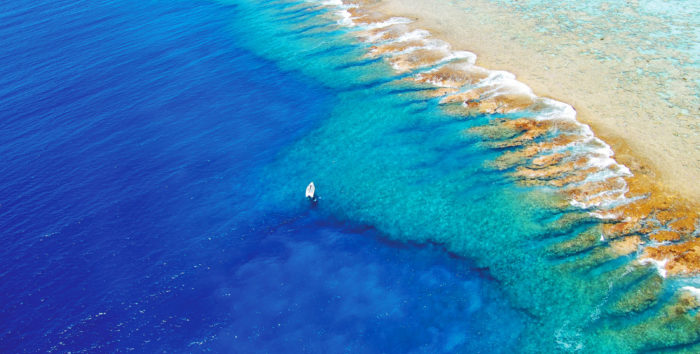The travel bug bit me relatively late in life. I used to think traveling was just *okay* until my first trip to Paris in 2014–and since then, I’ve realized that while I am still definitely a homebody, there are places you’ll visit for the first time and feel like you’ve come home.
Right now, I’m in full travel planning mode for my upcoming trip to Amsterdam and Norway to celebrate a big milestone–my 30th birthday! But this time around, I have something else in mind, in addition to booking accommodations and researching sights and restaurants: how to make my trip eco-friendly, and carbon-neutral if that’s possible.
This is nothing new, per se. An astonishing 6 billion “eco-tourists” travel the world every year; eco-tourism is a big business. Lately, a lot of outrageously glamorous eco-resorts have popped up in the most secluded places in the world, presumably running on raindrops and sunshine alone.
For example, months ago I read about Leo DiCaprio’s own birthday trip to Tetiaroa, a private island in French Polynesia. Its website explains in a calm and ethereal manner how the resort is all LEED certified, carbon-neutral, and run in a way that respects the island’s people, flora, fauna, traditions, earth, sky, and the moon. Seriously, nothing was left out of its respect, and I was kind of turned on. But I googled the island and discovered how far away it is from everything–if your two closest neighbors are New Zealand and Peru, you know you’re in the middle of nowhere. You have to take a private plane there–which means a ton of fuel burned just for Leo and the gang.

Got $5,000 to burn? You could shower like Leo in this breathtaking bathroom! (Oh that’s $5,000 a night, mind).
This brings us to the question of eco-friendly travel. It doesn’t take a rocket scientist to know that environmentally conscious traveling is more than just a matter of choosing a green hotel/resort (although don’t let that discourage you from going to one!). You have to look at the whole impact of your travel. I turned to Irina Vishnevskaya, the founder and CEO of Alle Travel, for advice on how to see the world without leaving a mark on the Earth (or your conscience).
1. Think South of the border:
– “Costa Rica is historically the leader as far as eco-friendly destinations go. The country plans to go completely carbon-neutral by 2021, and they are well on their way already, with officials saying the country is now at 81% of their goal,” Irina points out. It’s also a nature lover’s paradise with gorgeous and varied ecosystems and a ton of fresh fruits and veggies. (Here’s our coverage of vegan traveling in Costa Rica.)
-“Belize is also starting to be a leader in environmentally conscientious and sustainable tourism, and they’ve committed to the 10-island challenge, with the goal of eventually becoming 100% reliable on renewable energy.” 10 Island Challenge is an initiative begun by Carbon War Room, a nonprofit dedicated to fighting climate change. (As an aside, I fully approve of the name “war room”–that war is totally Peaceful Dumpling-approved).
Coincidentally, Leo DiCaprio is also investing in a new eco resort called Blackadore Caye in Belize that seeks to protect and preserve its unique ecosystem, that’s set to open in 2018. It’s supposed to allocate 1/2 of the space as a wildlife preserve, use 100% renewable energy, and serve as a model of sustainability. (I know I sounded a wee critical of Leo earlier, but I think his heart is basically pure, come on).
-“Uruguay is leading the way as far as renewable energy (94.5% of its electricity), and the country was named as a Green Energy Leader by the World Wildlife Fund.”
– Irina notes that for US travelers, these destinations are also relatively close, meaning that the carbon footprint of your flight will be less than other places in the world. This is a good rule of thumb for travelers anywhere in the world–think, is this in my hemisphere? If you have to take 3 planes over 16 hours, it’s going to leave some serious environmental impact.
2. Not just where, but *how* you travel matters.
– Eat Local: “One of the best things you can do when traveling is to eat food that is as local as possible–everything that needs to be imported to suit your foreign palate leaves a carbon footprint. And this applies to drinking, too–please don’t order French wine at a restaurant in Costa Rica,” recommends Irina.
Say No to Pools: Ever look at the pictures of those infinity pools right next to the beach and wonder, “Is that really necessary?” Your instincts would be correct–pools come with a huge energy and water wastage. So choose a hotel without one and enjoy the sea or ocean wherever you are–just like nature intended!
– Respect wildlife: “Sadly, animals are often abused to please tourists in search of new Facebook profile pictures. Please don’t ride an elephant. Ever. There’s no “pain-free” way to do so; if you want to hang out with elephants, choose instead an elephant sanctuary (like this one). Taking pictures hanging out with a tiger is a big no-no (they are drugged) and same goes for swimming with dolphins,” says Irina.
– Blue Flag beaches: If you’re looking for sun and sand, go to Blue Flag Beaches. Not only are these often cleaner and more well-maintained, they pass stringent standards for water quality and safety, as well as general environmental management criteria.
– Green Key Hotels: This is a hotel program that aims to reduce utility consumption, waste, and emissions.
– Think sensible: bring your reusable water bottle. This sounds too simple to be listed here, but recently a friend who traveled to Thailand reported being shocked at how many millions (billions?!) of water bottles the tourists generated there–and there were ZERO recycling bins around. No surprise that Thailand is one of 5 countries that dump more plastic into the oceans than the rest of the world combined… Don’t be that tourist who dumps plastic water bottles. It’s terrible anywhere in the world.
3. Offset your carbon footprint before you take off on your trip.
While incorporating Irina’s tips, I’m also going to reduce my carbon emissions before leaving. I used a carbon calculator to gauge my trip’s impact (mostly due to the transatlantic flight) and will change my daily habits to earn “points.” Since I’m vegan, ride the subway daily, compost, don’t even do laundry that often (:D), hate bright lights (mmm all about dim), and don’t own an air conditioner, I’m doing pretty good–but not super excellent. My challenge is to reduce plastic waste: although I recycle, any sort of thing that needs to be processed takes water and energy (no brainer). So that means fewer delicious pre-packaged beverages for me! Actually, a sort of mindfulness about my food and not just eating because it’s fun would be beneficial since food production naturally has a ton of environmental impact. I also plan on not buying new clothes or accessories until my trip, since fashion is the second most polluting industry in the world.
Have you taken a deliberately eco-friendly, carbon-neutral trip?
Related: Here’s How to *Actually* Do Tulum, Mexico Like A Green Traveler
How to Reduce Your Carbon Footprint While Travelling
How To Take A Wildly Enchanting (& Sustainable) Trip To New Orleans
Get more like this–sign up for our newsletter for exclusive inspirational content!
__
Photo: Tetiaroa; Aubrey Gates King; Unsplash







